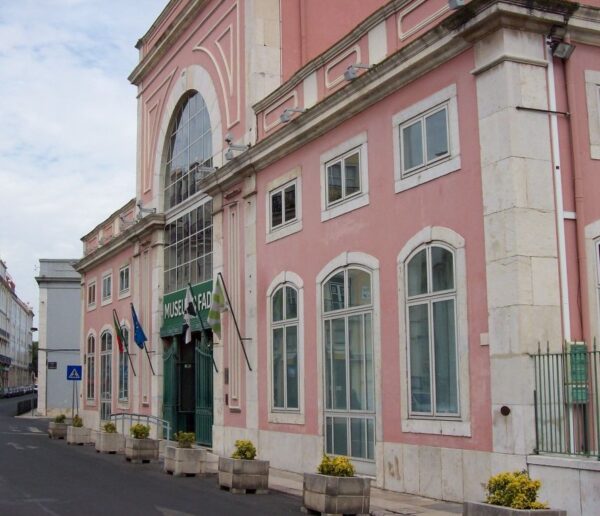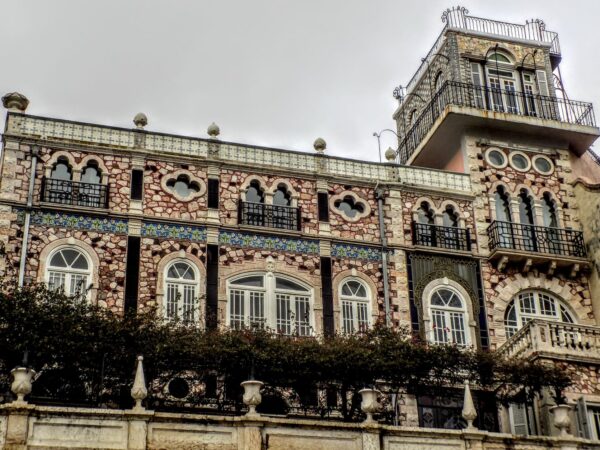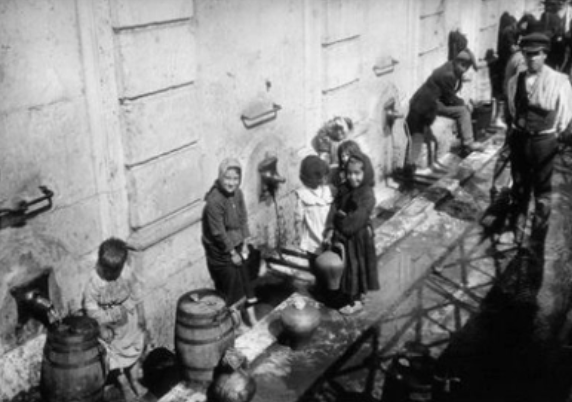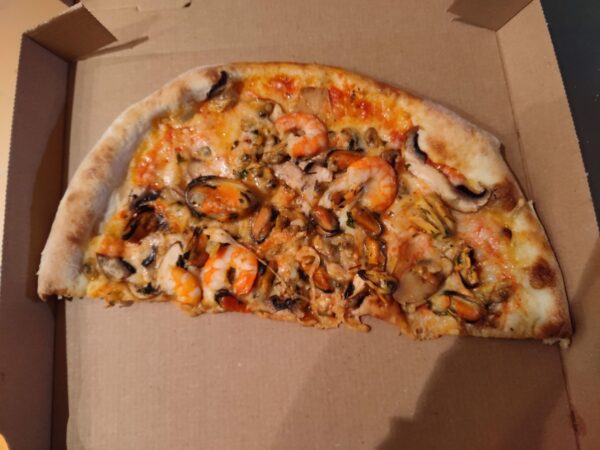Even though I’d tried to walk off last night’s dinner, the combination of perhaps one glass of port too many, dark clouds, and rain on a Sunday morning coming down kept me in bed later than I’d been on any other day during my stay. Brushing away the mental cobwebs, I headed straight for the kitchen to plug in the electric pot and get the water boiling for what I knew would be several cups of chá preto – black tea. While I was waiting, I sliced some bread and fired up my laptop to see if this was going to be another day long rain or if I had some hope of dodging rain bursts and getting in a walk or two or whether I’d again be lazing on a Sunday afternoon.
There was little question that the morning would be a washout but the forecast left some hope for the afternoon. However, simply because I’d be flat bound for several hours, didn’t mean the time had to be unproductive. If nothing else it gave me one more opportunity to get a sense of what ordinary life might be like for me if I adopt Lisboa as a second home.
Museu do Fado.
As I’ve noted elsewhere in this blog, one of the advantages to staying in Baixa is its relative proximity to so many of the sights most people want to see when they visit Lisboa and the Museu do Fado (Fado Museum) is no exception.

At barely more than a kilometer away over the flattest terrain possible, had I walked directly there from the apartment, I’d have arrived in less than 10 minutes. However, since I hadn’t walked anywhere in the early morning, I took a circuitous route that was three or four times that distance.
If you’re unfamiliar with fado, you might want to read this post from my spring trip. The music of fado, is the soul of Portugal so it’s fitting that it would have its own museum. I wrote at the time,
If a single word, saudade, can, as many say, capture the temperament of a nation then no single style of music captures that feeling more than fado. Saudade is a feeling of melancholy, longing, and nostalgia. The etymological root of the word fado is the Latin fatum meaning fate.
It’s also fitting that the museum is located in Lisbon – the birthplace of fado although for some, the university town of Coimbra asserts a claim that its style currently upholds more traditional fado. (You might also recall the photo of the small monument in Mouraria that acknowledges the music’s origin in Lisboa.) In recognition of its importance to Portugal and the world, fado was added to the UNESCO list of Intangible World Cultural Heritage in 2011.
Among the highlights of my visit to this museum was the chance to see probably the world’s most famous fado themed painting by JosĂ© Melhoa called O Fado that I reproduced from Wikimedia on my original trip but that’s now part of my personal experience.

I see the Rain.
By the time I finished walking through the Fado Museum, the rain had returned. At this point it was more a persistent drizzle but it was hinting that a hard rain’s gonna fall – and imminently – so in this instance I made a beeline directly back to the flat. Along the way, however, I passed this building:.

As Ana and I were walking through Alfama Thursday, we passed behind a building that I found interesting enough to photograph. Ana told me that the building itself was now a hotel but that at one time, it was the oldest fountain in Lisbon. It’s called the Chafariz de El-Rei or King’s Fountain. This is the front of that structure.
The fountain was built in the 13th century and was expanded twice. First by Dom Dinis, who elevated the importance of Lisboa as a center of culture and learning, and later in the 15th century by Dom JoĂŁo II. The fountain itself transported water from the hills of Alfama (you might recall that the likely etymology of Alfama is from the Arabic for bath or spring) to a point near the river. At its peak it had nine nozzles each with a specific purpose. One was to supply ships. One was limited to use by the nobility. And so on. It was still in use in the early 20th century as this 1907 photo by Joshua Benoiel (taken from the website The Lisboner) shows.

The current façade dates from 1864 and hides a luxury boutique hotel called the Palacete Chafariz del Rei.
The fountain was also the subject of a particularly interesting and much discussed 16th century painting (between 1570 and 1580) by an unknown Flemish painter.

If you take a close look at the painting, you’ll see that unlike most depictions of Renaissance Europe, a substantial number of the people in the painting are Black. (One analysis I read puts the number at 30%.) This would be very much in keeping with Lisbon’s population at the time because it’s estimated that perhaps 20% of its citizenry was, in fact, African or people of African descent. This would have been the largest such population in Europe at the time. If you’re interested, you can read an in depth exploration of the painting here – the website from which I copied the picture.
Ten minutes or so after I got in the door to the apartment, the skies opened with an intensity that echoed yesterday’s downpours. Still, as I mentioned above, this didn’t mean the day would pass unproductively. It didn’t. Here’s what I accomplished over the remains of the day:
- I finished one of the two books I’d brought with me and started reading the second.
- I updated three of the older posts on this blog editing them from the original long format to my newly preferred shorter form of 1,500 words or fewer.
(I might have accomplished more with regard to the writing but I’m a poor enough typist on a standard keyboard. Typing on my laptop presents an additional challenge to my barely competent fingers.)
A respite from the rain came late in the afternoon and, although it was relatively brief, it was long enough for me to squeeze in about a 20 minute walk even though, like last night, I didn’t venture outside the neighborhood.
I did stop in the House of Cork where I considered buying a pair of cork shoes. Sadly, I didn’t particularly like the shoes they had that fit me and they didn’t have the shoes I liked in my size. I did engage the young woman in the shop in a brief conversation when I learned she was from Brazil. We talked about my travels there and I asked her if the Lisboetas tease her about her Portuguese. She responded, “All the time.”
This is one of the challenges of trying to learn Portuguese from an app. I think because there are more than 200 million Brazilians and, in part, Brazilian dialect is rather more Spanish like than is European Portuguese, nearly all of them teach Brazilian Portuguese. Comparing my experiences with the language in Rio and Lisbon, I thought that the differences between the two are captured by the differences between the musical styles that seem to represent the two countries. European Portuguese is fado and Brazilian Portuguese is samba. In a second instance of fortunate timing, the rain returned shortly after I reached the apartment.
By the time I was ready to eat dinner, the rain had slowed to a drizzle and I decided I’d try a pizza at Dama e Vagabundo which was not far from the flat. Because I was a lone diner, I was able to grab a seat inside. I ordered the Mari e Monti pizza (among the most expensive on the menu at €17) and was going to order a medium beer. My server looked at me closely and suggested the small beer might be enough. She was right. Though I was able to finish the beer, the pizza was so big that I took half of it home. It’s a rare occurrence when a server encourages you to spend less money and I went out of my way to thank her. She simply replied, “It’s my job.”
I don’t usually photograph my food but when I got home I made an exception for the leftover pizza topped with clams, shrimp, mussels, and mushrooms.

I have a few more photos from the day here.
OMG, that pizza looks amazing! Glad you got a picture!
It was.
Interesting about the word fado. In Gaelic it means “long ago” and is used in storytelling instead of “once upon a time.” Same spelling – different language!
Perhaps equally interesting is that the Celts (of whom the Gaels were a part) likely migrated from Iberia to the British Isles.